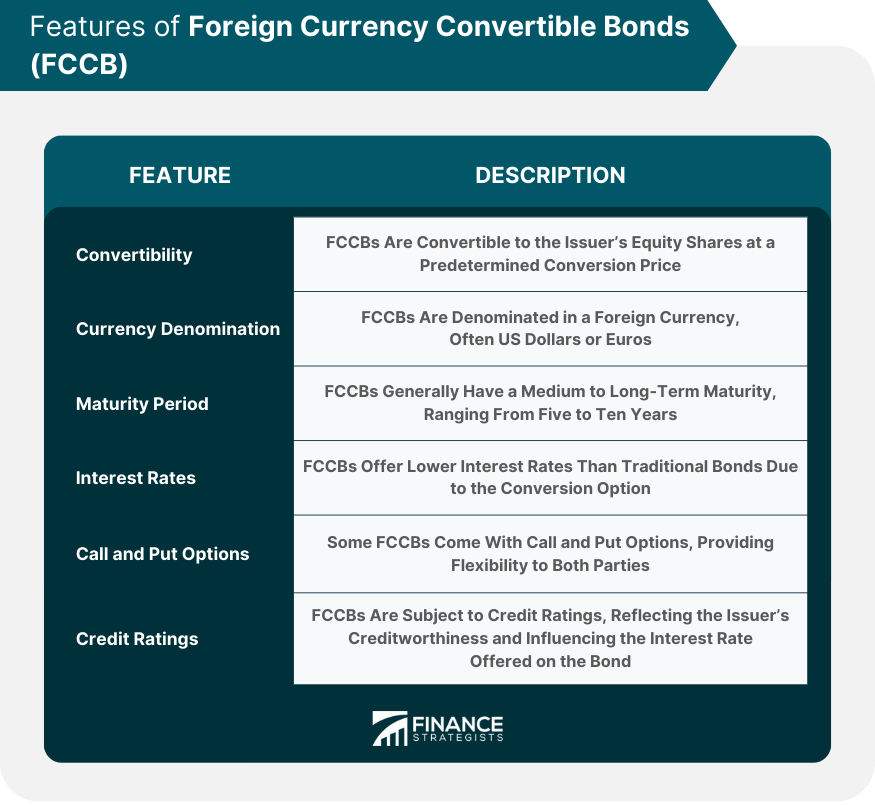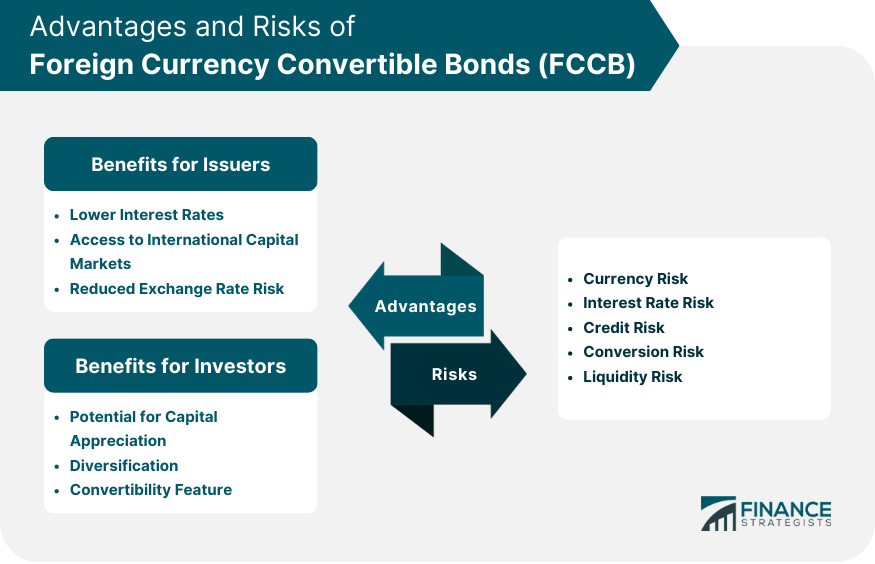Foreign Currency Convertible Bonds are a type of hybrid financial instrument combining features of both debt and equity. They are bonds issued by a company in a foreign currency, typically US dollars or euros, with an option for the bondholder to convert the bond into the company's equity shares at a predetermined conversion price. The primary purpose of issuing FCCBs is to raise capital in international markets at a lower cost than traditional debt financing. This is because the convertibility feature adds an element of potential capital appreciation, making them more attractive to investors and enabling issuers to offer lower interest rates. FCCBs have gained prominence in recent years, with many companies across industries and regions choosing this financing method to access international capital markets. The market for FCCBs is constantly evolving, driven by changes in regulations, investor preferences, and global economic conditions. FCCBs possess several unique features that differentiate them from traditional bonds and make them attractive to both issuers and investors. The most distinctive feature of FCCBs is their convertibility. Bondholders have the option to convert their bonds into the issuer's equity shares at a predetermined conversion price, typically within a specified period or on specific dates. FCCBs are denominated in a foreign currency, often US dollars or euros. This allows issuers to tap into international capital markets and helps investors diversify their portfolios by investing in foreign currency-denominated assets. The maturity period of FCCBs can vary, but they generally have a medium to long-term maturity, ranging from five to ten years. This extended maturity period provides issuers with a longer time horizon to repay the debt, reducing the burden on their cash flows. Interest rates on FCCBs are typically lower than those on traditional bonds, as the conversion option makes them more attractive to investors. The interest payments may be fixed or floating, with floating rates usually linked to a reference rate, such as LIBOR. Some FCCBs come with put and call options, giving the issuer or bondholder the right, but not the obligation, to redeem the bonds before the maturity date. This feature provides flexibility to both parties, allowing them to respond to changes in market conditions. FCCBs, like other debt instruments, are subject to credit ratings by agencies such as Moody's, Standard & Poor's, and Fitch Ratings. The credit rating reflects the issuer's creditworthiness and ability to repay the debt, influencing the interest rate offered on the bond. FCCBs offer a range of benefits for both issuers and investors, making them an attractive financing option for companies looking to raise capital in international markets. One of the primary advantages of FCCBs for issuers is the lower interest rates they attract compared to traditional bonds. The convertibility feature offers investors the potential for capital appreciation, allowing issuers to offer lower interest rates. FCCBs enable issuers to access international capital markets, diversifying their investor base and expanding their funding options. This can be especially beneficial for companies in emerging markets or those looking to raise capital for expansion or growth initiatives. As FCCBs are denominated in foreign currency, issuers can use the proceeds to fund overseas operations or acquisitions, reducing their exposure to exchange rate fluctuations. This can be particularly advantageous for companies with significant foreign currency liabilities or those operating in multiple countries. The convertibility feature of FCCBs offers investors the potential for capital appreciation if the issuer's share price increases. This provides an opportunity for investors to benefit from both interest income and potential equity gains. Investing in FCCBs allows investors to diversify their portfolios by adding foreign currency-denominated assets. This can help reduce portfolio risk and improve overall returns. The convertibility feature of FCCBs offers investors the flexibility to choose between receiving interest income from the bond or converting it into equity shares for potential capital appreciation. This optionality can be appealing to investors with varying risk appetites and investment objectives. While FCCBs offer several advantages, they also come with inherent risks that investors must consider before investing. As FCCBs are denominated in foreign currency, investors are exposed to foreign currency risk due to potential fluctuations in exchange rates. A depreciation in the investor's home currency against the bond's currency can result in losses when the bond is redeemed or converted. Interest rate risk arises from the potential for changes in market interest rates to affect the value of FCCBs. An increase in market interest rates can lead to a decline in the bond's price, resulting in capital losses for investors. Investors in FCCBs face credit risk, as the issuer's ability to meet its interest and principal repayment obligations can be affected by its financial performance and market conditions. A downgrade in the issuer's credit rating can negatively impact the bond's value. Conversion risk refers to the uncertainty surrounding the conversion price and timing. If the issuer's share price does not increase as expected, bondholders may choose not to convert their bonds into equity, resulting in lower returns than anticipated. FCCBs can sometimes suffer from liquidity risk, as they may not be as widely traded as traditional bonds or equities. This can make it difficult for investors to buy or sell the bonds in the secondary market, potentially impacting their ability to exit the investment. The process of issuing FCCBs involves several stages, including regulatory approvals, selecting underwriters and legal counsel, drafting the prospectus, pricing and allocation, and listing and trading. Companies planning to issue FCCBs must obtain approvals from relevant regulatory authorities, both in their home country and in the jurisdiction where the bonds will be listed. This may involve meeting specific eligibility criteria and providing necessary documentation. Issuers typically engage investment banks to act as underwriters and legal counsel to assist with the issuance process. These professionals help the issuer navigate the complex regulatory landscape, structure the bond, and market it to potential investors. A prospectus containing detailed information about the issuer, the bond, and the associated risks must be prepared and submitted to the relevant regulatory authorities for approval. This document serves as a key source of information for potential investors to make informed investment decisions. Once the prospectus is approved, the issuer and underwriters determine the pricing of the FCCB, taking into account factors such as market conditions, investor demand, and the issuer's credit rating. The bonds are then allocated to investors, with institutional investors often receiving a significant portion of the allocation due to their large investment capacity. After the allocation process, FCCBs are listed on a stock exchange, typically in the jurisdiction where they were issued. This facilitates trading in the secondary market, allowing investors to buy and sell the bonds. The bonds may also be listed on multiple exchanges to enhance their liquidity and visibility. Foreign Currency Convertible Bonds (FCCBs) serve as a valuable financing instrument for companies looking to access capital in international markets. They offer numerous advantages for both issuers and investors, such as lower borrowing costs, global capital access, portfolio diversification, and the opportunity for capital appreciation. Nonetheless, investing in FCCBs also entails certain risks, including currency, interest rate, credit, conversion, and liquidity risks. Investors must carefully weigh these risks before making any investment decisions. In recent years, the FCCB market has experienced significant growth, driven by a growing number of issuers exploring international markets for funding. As global economic conditions continue to change, FCCBs are expected to maintain their prominence as a key financing option for companies seeking to diversify their funding sources and seize opportunities in the international market. The success of FCCBs in connecting global capital with investment opportunities demonstrates the crucial role they play in the world of finance.What Is a Foreign Currency Convertible Bond (FCCB)?
Features of Foreign Currency Convertible Bonds
Convertibility
Currency Denomination
Maturity Period
Interest Rates
Put and Call Options
Credit Ratings

Advantages of Foreign Currency Convertible Bonds
Benefits for Issuers
Lower Interest Rates
Access to International Capital Markets
Reduced Exchange Rate Risk
Benefits for Investors
Potential for Capital Appreciation
Diversification
Convertibility Feature
Risks Associated With Foreign Currency Convertible Bonds
Currency Risk
Interest Rate Risk
Credit Risk
Conversion Risk
Liquidity Risk

Issuing Process of Foreign Currency Convertible Bonds
Regulatory Approvals
Selecting Underwriters and Legal Counsel
Drafting the Prospectus
Pricing and Allocation
Listing and Trading
Conclusion
Foreign Currency Convertible Bond (FCCB) FAQs
A Foreign Currency Convertible Bond is a type of convertible bond that is issued in a currency other than the issuer's domestic currency, and can be converted into equity shares of the issuing company.
FCCBs work like regular convertible bonds, but with the added feature that they are issued in a foreign currency. This allows issuers to tap into a wider pool of investors and raise capital at a lower cost than they might otherwise be able to.
The benefits of investing in an FCCB include the potential for capital appreciation if the underlying equity shares of the issuer appreciate in value, as well as the regular interest payments that are made to bondholders.
The risks associated with investing in an FCCB include currency risk, as changes in exchange rates can impact the value of the bond, as well as credit risk, which is the risk that the issuer will default on the bond.
FCCBs are typically issued by companies based in emerging markets that are looking to raise capital from a wider pool of investors. These companies may have limited access to domestic capital markets and may be seeking to raise capital at a lower cost than they might otherwise be able to.
True Tamplin is a published author, public speaker, CEO of UpDigital, and founder of Finance Strategists.
True is a Certified Educator in Personal Finance (CEPF®), author of The Handy Financial Ratios Guide, a member of the Society for Advancing Business Editing and Writing, contributes to his financial education site, Finance Strategists, and has spoken to various financial communities such as the CFA Institute, as well as university students like his Alma mater, Biola University, where he received a bachelor of science in business and data analytics.
To learn more about True, visit his personal website or view his author profiles on Amazon, Nasdaq and Forbes.















